Description
This is the third installment of our series, examining Michael Jackson’s demos, alternate versions, and unreleased songs in chronological order as much as possible to see how the monster album “Thriller” was made. “Nite Line” was written by Glen Ballard, Bree Howard, and Davey Faragher, produced by Quincy Jones, and recorded during the “Thriller” sessions in August 1982. However, it was not used and was offered to the Pointer Sisters, who renamed it “Nightline” and included it on the album “Break Out.” Randy Crawford also contributed and it is included as the first track on the album “Niteline.” Here we have a leaked recording of Michael’s vocals. “Hot Street” was written by Rod Temperton, produced by Quincy Jones, and recorded at Westlake Recording Studios in August and September 1982. It was originally titled “Slapstick” and had completely different lyrics. Michael really liked this song and wanted to include it on the album, but in the end it was decided that it wasn’t strong enough to be included. Michael said, “Yeah, I like ‘Hot Street’. I love that song. Quincy and Rod didn’t think it was good enough, but I thought it was great.” The lyrics of “Slapstick” – “I need a slapstick comedy, because that love will make you smile” – reflect Michael’s love of movies. On the other hand, the lyrics of “Hot Street” – “The streets are hot! Just feel the beat of the night! The fantasy never stops!” – are honestly a bit rustic. Before the lyrics, I think the reason Michael liked it is because it is one of Rod Temperton’s best danceable songs. However, it was probably left out of “Thriller” because it would have been seen as a rehash of the songs on “Off The Wall.” “Thriller” had to be better than “Off The Wall.” “Hot Street” has not been offered to any other artists, but perhaps Michael had Rod put it on hold, thinking that he might use it on another album someday. “Carousel” was written by Michael Sembello and Don Freeman, produced by Quincy Jones, and recorded in August and September 1982. The lyrics are not bad, “I’m a clown, you’re a dancer, the circus girl broke my heart on the merry-go-round,” but the melody is excellent. However, it was not included in “Thriller.” And it was never sung by any other artist other than Michael, so it remained buried without being released to the public. In addition to the official version, this time we have also included the leaked 11-second intro, the full-length version with a 10-second longer ending, the edited version only included in “Thriller 25,” and a fan-mixed version that adds Michael’s main vocals and performances to the performances and chorus using the demos made by Michael Sembello. Michael and Quincy asked Rod to give “Starlight” a more mysterious and scary atmosphere. “I woke up and said these words… I was saying in my head, this is the title! And I could imagine it topping the Billboard charts. I think the word ‘Thriller’ jumping out as something to be noted is a symbol of merchandising.” After Rod Temperton’s “Starlight,” the song was also considered for the title “Midnight Man,” but “Thriller” was ultimately chosen as the title. Once the song title was decided, Rod is said to have rewritten the entire lyrics in “a few hours.” The bridge is spoken by horror movie actor Vincent Price. “Thriller” was recorded from September to November 1982. Engineer Bruce Swedien had Michael record the vocals with different approaches, doing double takes and recording at different distances from the microphone. Some of the backing vocals were recorded in the shower room at Westlake Studios. The bass line was performed on a Roland Jupiter-8 synthesizer, and the verses were layered on a Sequential Circuits Prophet 5. The percussion was created on a Linn drum modified with sound chips from two other drum machines (snare, hi-hat, and congas from an LM-1, and claps from a TR-808). “Thriller” also features Rhodes piano from Greg Phillinganes and guitar from David Williams. To record the wolf howls, Swedien spent the whole night in the barn around a Great Dane, setting up a tape recorder, but the dog wouldn’t howl. So Michael decided to record the howls himself. For the creaking door sound, Swedien borrowed a door from Universal Studios and recorded the sound of its hinges. Here is a demo of “Thriller” without the creaking door, the howling, the drums, and the sudden end without Vincent Price’s voice. A demo of “Wanna Be Startin’ Somethin'” was made in 1978 (included in Vol.1). It was re-recorded in September 1982, and finally completed in November to become the first track on “Thriller”. You might think that it would be a perfect opening song because it’s about “wanting to start something”, but the song is about paparazzi and others who “want to make trouble”, and attacks them with the song, saying “I’m going to make you feel the pain of lightning”. First, there is a 31-second snippet, and there are no horns or keyboard sounds yet, so it doesn’t go beyond the realm of a demo at all. The 1978 demo didn’t have horns, but it did have keyboard sounds. So it may be the oldest demo, but it’s unclear. Then there is a recording that is said to be a demo from 1981. They shouldn’t have re-recorded it in 1981, but I’ll leave it unchanged for now. First, there are horns by Jerry Hey and the Seawind Horns. There is also keyboard sounds by Greg Philligaines. And the bass line of Louis Johnson is in front, the hi-hat sound and guitar are in the back, there is a groove, but there is no kaleidoscope development and it is monotonous. And then there is the demo that seems to be from September 1982. The horn is sounding, but it is almost inaudible, so I wonder what on earth this is for. Therefore, the development of Manu Dibango’s “Soul Makossa” at the end is very monotonous. However, it is played about 15 seconds longer than the album version. “P.Y.T. (Pretty Young Thing)” was composed and recorded in September 1982. Quincy Jones called his wife “pretty young girl”, so he asked several songwriters to write a song based on the title “Pretty Young Thing”. Michael and Greg Phillinganes wrote a mid-tempo demo together. That is the version recorded this time. But Quincy wanted a more danceable song, so James Ingram’s version was chosen and included on Thriller. Quincy’s decision was right. “The Lady In My Life” was first recorded in September ’82 and finished in November of the same year. Michael said that this was one of the most difficult songs to write for the album. “We were used to doing multiple takes to get the vocals as perfect as possible, but Quincy wasn’t satisfied with my work on this song even after literally dozens of takes. Finally, at the end of one session, he called me and begged me, literally begging me to come back to the studio and sing it. So I went back to the studio, had the lights turned off, and closed the curtain between the studio and the control room so I wouldn’t be embarrassed. Q played the tape, and I begged. That’s what you hear in the groove.” There was a long version on the 2002 promo CD, The Songs Of Rod Temperton. We’ve included that, but we’ve included the true full-length version #2, which is about 15 seconds longer than the original. First, it has different lyrics, longer never-before-heard verses, choruses, and outros. These were cut to fit on one LP. “Human Nature” was written by Steve Porcaro, a member of the band Toto and keyboardist. Porcaro came up with the song while talking to his daughter after a boy pushed her off a slide. He told her that boys probably like you and that’s human nature (now that’s a no-no). Porcaro recorded a demo of “Human Nature” while mixing the hit “Africa” with the Toto members in the studio. David Paich contributed on synthesizers. It was suggested that someone other than Toto use “Human Nature” because the other members felt that it wasn’t rock enough. Porcaro helped create Thriller with some of the band members of Toto, but he didn’t think that Michael would use “Human Nature” at the time. One day, Paich and Porcaro gave the demo to Quincy Jones. Quincy listened to most of the demos and decided that “Human Nature” was the best fit for the album. However, he wasn’t satisfied with the lyrics, so he asked John Bettis to help him rewrite them. The demo was made on October 2, 1982, in the key of C major. However, the key was raised by one for the album version. The original demo with a lower key was supposed to be included in “Thriller 40” but was shelved. Michael was still trying to figure out how to sing it, and at the end he said it was interesting and enjoyed it, making it a very interesting take. It certainly seems that Michael is not in good spirits when the key is low. And the Alternate Mix that was included on the promo 3-inch single from the 1987 Japan tour, the ending is the same, but the outro before that is about 20 seconds shorter. It is an edited version. “Human Nature” was the last-minute finalist to replace “Carousel.” “Beat It” was recorded in early October 1982. It was produced by Quincy Jones. According to the documentary “Thriller 40,” Michael wanted “Beat It” to have a rock-oriented sound because MTV didn’t show music videos of black artists and “they only showed rock music.” He also wanted this song to be different from the sound of his 1979 album “Off the Wall.” Michael wanted a guitarist who would attract the attention of white male audiences, so he asked Eddie Van Halen to play guitar. “If I was buying a rock song, I wanted to write a song like this, like that… and the kids,”I wanted it to be really fun for kids in grade school and college alike.” Michael Jackson, Ebony, May ’84. For “Beat It,” the backing track was recorded first, and Eddie overdubbed the guitar solo later. The solo is in the verse, but it was edited out because it was the best part. However, it interfered with the SMPTE timecode of the song’s 24-track tape, and the reels couldn’t be synchronized. So, at Sunset Sound, Steve Lukather and Jeff Porcaro of Toto had to re-record Michael’s vocals, Van Halen’s solo, drums, bass, guitar, and the song on tape in “reverse.” Eddie also changed the arrangement of the song. To be precise, he changed the chords of the solo part from the song. Steve Lukather also acknowledged in an interview with YouTuber Rick Beato that it worked better. In an interview with Piers Morgan, Eddie talks about working with Michael: Eddie Van Halen never received any payment for playing the solo on this song. “I was asked to do it. I didn’t ask for anything. It was about 20 minutes of my life. Quincy called me and asked if I wanted to do it. To be honest, the band’s policy at the time was, ‘Don’t do anything outside of the band.’ But I didn’t have anyone, I couldn’t ask for advice. I thought, if I play on this record for black kids, no one’s going to know.” Eddie Van Halen, Piers Morgan, May 3, 2013. Also, in an interview with The Guardian, his brother Alex Van Halen said that Dave Lee Roth used Eddie’s work as an excuse to eventually leave the band. We have included the demo from This Is It, as well as Album Mix #06, which ends with Michael’s repeated “beat it” voice, as heard in the 2008 game Guitar Hero: World Tour. 1982 August 1.Nite Line 1982 August to September 2.Slapstick 3.Hot Street 4.Carousel (Full Version) 5.Carousel (Edit Version) 6.Carousel 7.Carousel (feat. Michael Sembello Mix Version) 1982 September to November 8.Thriller (Vincent Prince Voice-Over) 9.Thriller (Demo) 10.Wanna Be Startin’ Somethin’ (Home Demo Excerpt) 11.Wanna Be Startin’ Somethin’ (1981 Demo) 12.Wanna Be Startin’ Somethin’ (1982 Demo) 1982 September 13.P.Y.T. (Full Version #2) 1982 September to October 16.Human Nature (Demo) 17.Human Nature (Alternate Mix) 3″ Souvenir single for the Japan Tour 87 1982 Early October 18.Beat It (Demo) 19.Beat It (Album Mix #06) Guitar Hero: World Tour
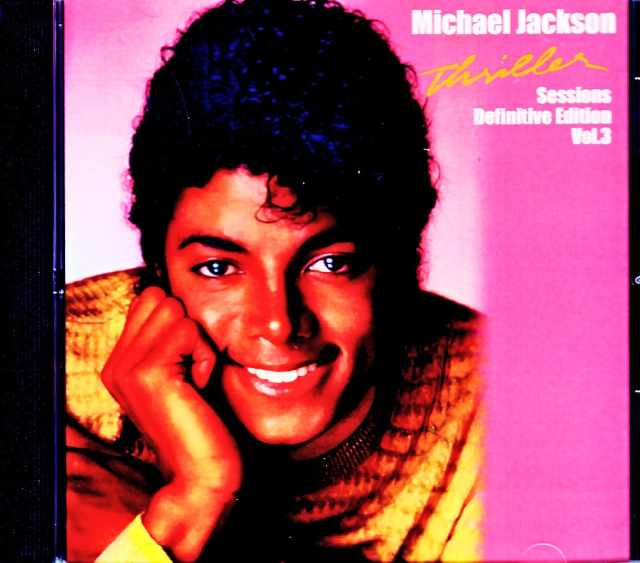
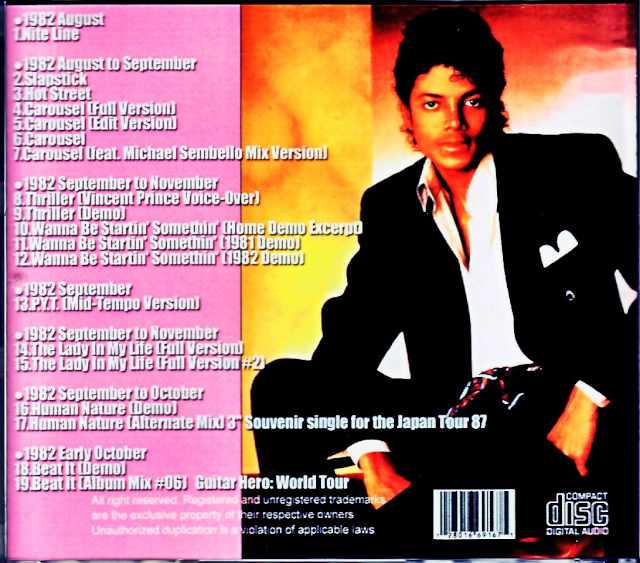

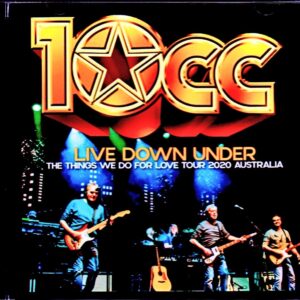
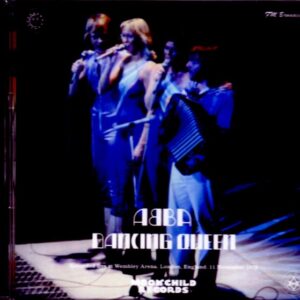
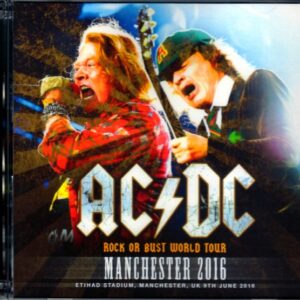
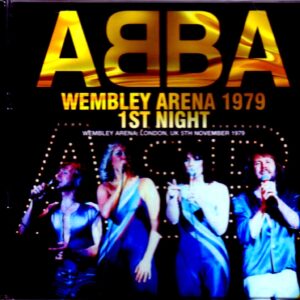
Reviews
There are no reviews yet.